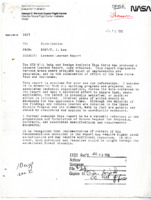
Lawrence J. Thomson Collection
Dublin Core
Identifier
Lawrence J. Thomson Collection
Title
Lawrence J. Thomson Collection
Description
Lawrence J. Thomson was born on August 18, 1925 and died February 1, 2004. In 1941, Thomson enlisted in the Merchant Marines; in 1944 he enlisted with the U.S. Marine Corps. Following World War II, Thomson graduated with a bachelor’s degree in mechanical engineering from Auburn University. From 1953 to 1956, he worked in the development of the Liquid Oxygen/RPI rocket motor technologies while working for North American Aviation in Canoga Park, CA.
Thomson worked for Rust Engineering in Birmingham from 1957 to 1960, then came to work for the Army Ballistic Missile Agency in Huntsville, before his transfer to the Marshall Center when it was opened on July 1, 1960. Thomson served as a test engineer during the Mercury, Gemini, and Apollo programs during the development of the H-1, J-2, and F-1 engines for NASA.
In 1968, NASA selected Thomson to begin preliminary design studies in development of the Space Shuttle main engine. From 1971 to 1986, Thomson served as chief engineer for the Space Shuttle main engine, and in that position, he organized the engineering efforts at Marshall, supporting 23 Shuttle flights. In 1981, Thomson was awarded the NASA Exceptional Service Medal for his contribution to the success of Space Shuttle propulsion.
Thomson retired from his position at the Marshall Center in 1989, and he went to work with Aerojet in Sacramento, CA., until 1995 as chief scientist for advanced propulsion. Following his work at Aerojet, Thomson returned to Huntsville.
Thomson worked for Rust Engineering in Birmingham from 1957 to 1960, then came to work for the Army Ballistic Missile Agency in Huntsville, before his transfer to the Marshall Center when it was opened on July 1, 1960. Thomson served as a test engineer during the Mercury, Gemini, and Apollo programs during the development of the H-1, J-2, and F-1 engines for NASA.
In 1968, NASA selected Thomson to begin preliminary design studies in development of the Space Shuttle main engine. From 1971 to 1986, Thomson served as chief engineer for the Space Shuttle main engine, and in that position, he organized the engineering efforts at Marshall, supporting 23 Shuttle flights. In 1981, Thomson was awarded the NASA Exceptional Service Medal for his contribution to the success of Space Shuttle propulsion.
Thomson retired from his position at the Marshall Center in 1989, and he went to work with Aerojet in Sacramento, CA., until 1995 as chief scientist for advanced propulsion. Following his work at Aerojet, Thomson returned to Huntsville.
Collection Tree
- Space Collections
- Lawrence J. Thomson Collection
